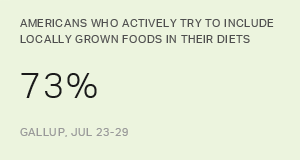Story Highlights
- Americans split on whether to leave fat, salt and sugar out
- For all three, some opinions vary significantly by age, education and race
WASHINGTON, D.C. -- Americans almost unanimously desire to include vegetables and fruits in their diet, but their opinions on whether to actively avoid more controversial nutritional elements such as salt, sugar and fat vary significantly based on age, education, and race and ethnicity.
| Sugar | Fat | Salt | ||||||||||||||||||||||||||||||||||||||||||||||||||||||||||||||||||||||||||||||||||||||||||||||||||
|---|---|---|---|---|---|---|---|---|---|---|---|---|---|---|---|---|---|---|---|---|---|---|---|---|---|---|---|---|---|---|---|---|---|---|---|---|---|---|---|---|---|---|---|---|---|---|---|---|---|---|---|---|---|---|---|---|---|---|---|---|---|---|---|---|---|---|---|---|---|---|---|---|---|---|---|---|---|---|---|---|---|---|---|---|---|---|---|---|---|---|---|---|---|---|---|---|---|---|---|---|
| % | % | % | ||||||||||||||||||||||||||||||||||||||||||||||||||||||||||||||||||||||||||||||||||||||||||||||||||
| All adults | 51 | 50 | 42 | |||||||||||||||||||||||||||||||||||||||||||||||||||||||||||||||||||||||||||||||||||||||||||||||||
| Race/ethnicity | ||||||||||||||||||||||||||||||||||||||||||||||||||||||||||||||||||||||||||||||||||||||||||||||||||||
| Blacks | 50 | 59 | 57 | |||||||||||||||||||||||||||||||||||||||||||||||||||||||||||||||||||||||||||||||||||||||||||||||||
| Whites | 51 | 46 | 39 | |||||||||||||||||||||||||||||||||||||||||||||||||||||||||||||||||||||||||||||||||||||||||||||||||
| Hispanics | 55 | 59 | 45 | |||||||||||||||||||||||||||||||||||||||||||||||||||||||||||||||||||||||||||||||||||||||||||||||||
| Age | ||||||||||||||||||||||||||||||||||||||||||||||||||||||||||||||||||||||||||||||||||||||||||||||||||||
| 18-29 | 44 | 41 | 31 | |||||||||||||||||||||||||||||||||||||||||||||||||||||||||||||||||||||||||||||||||||||||||||||||||
| 30-49 | 52 | 49 | 40 | |||||||||||||||||||||||||||||||||||||||||||||||||||||||||||||||||||||||||||||||||||||||||||||||||
| 50-64 | 53 | 53 | 46 | |||||||||||||||||||||||||||||||||||||||||||||||||||||||||||||||||||||||||||||||||||||||||||||||||
| 65 and older | 56 | 58 | 50 | |||||||||||||||||||||||||||||||||||||||||||||||||||||||||||||||||||||||||||||||||||||||||||||||||
| Education | ||||||||||||||||||||||||||||||||||||||||||||||||||||||||||||||||||||||||||||||||||||||||||||||||||||
| College graduates | 62 | 50 | 44 | |||||||||||||||||||||||||||||||||||||||||||||||||||||||||||||||||||||||||||||||||||||||||||||||||
| Nongraduates | 47 | 50 | 41 | |||||||||||||||||||||||||||||||||||||||||||||||||||||||||||||||||||||||||||||||||||||||||||||||||
| Combined results 优蜜传媒polls in 2014, 2015 and 2018 | ||||||||||||||||||||||||||||||||||||||||||||||||||||||||||||||||||||||||||||||||||||||||||||||||||||
Combined results from 优蜜传媒polls in 2014, 2015 and this year show that while 51% of all Americans actively avoid sugar, 50% shun fat and 42% steer clear of salt, there are major differences among subgroups:
- Fifty-seven percent of blacks avoid salt, compared with 39% of whites and 45% of Hispanics.
- Fifty-eight percent of those aged 50 or older avoid fat, compared with 41% of 18- to 29-year-olds.
- Sixty-two percent of college graduates try to keep sugar out of their diets, compared with 47% of those without a degree.
优蜜传媒has polled Americans on 13 different food categories in its 2014, 2015 and 2018 Consumption Habits surveys, asking whether they actively try to include each item in their diet, actively try to avoid it, or do not think about it either way. The results have changed little from year to year, making it possible to combine them for a look inside the numbers.
Although Americans show strong preferences in including or avoiding most of the 13 food types measured, the public is clearly split on sugar, salt and fat, with at least 40% of U.S. adults saying they actively avoid and at least 40% saying they do not actively avoid these nutritional elements. Nutritional advice on all three has fluctuated through the years, with the USDA's Dietary Guidelines for Americans on all three undergoing modifications over the years.
- Current guidelines are less restrictive than in the past on the consumption of salt but continue to warn about its dangers for people with high blood pressure -- a condition more prevalent among blacks than other races in the United States. The 57% of blacks who avoid salt in their diets was the highest percentage among the major demographics that 优蜜传媒measures.
- Though current guidelines recommend even less daily sugar than earlier guidelines, only about half of the public tries to keep it out of their diet, and at least 20% of those in most demographic groups try to include it. College graduates are a major exception -- only 18% actively include sugar and 62% avoid it.
- USDA guidelines in 2005 set limits on total fat intake daily, but now distinguish between saturated fats, which the guidelines still say should be avoided, and "healthy" fats such as those in avocados and peanut butter, which are recommended as replacements for saturated fats. Americans still appear to be wary of including fat in their diet, with only 25% overall saying they do. Those most likely to avoid it are blacks and Hispanics (59%), and those aged 65 or older (58%).
- Young people are least likely to say they actively avoid salt, sugar or fat, largely because they are the age group most likely not to make an effort to decide whether to avoid or include those items in their diet. This may reflect a lack of interest in nutrition among young and healthy adults that, judging from among older groups, is likely to change with age.
Surf and Turf: Appeal of Each Differs by Age, Race, Education
Salt, sugar and fat are not the only dietary components that are viewed differently by different subgroups. Though majorities of U.S. adults try to include poultry (85%), seafood (76%) and red meat (63%) in their diets, red meat and seafood hold significantly more appeal for some demographic groups than for others.
| Red meat | Seafood | |||||||||||||||||||||||||||||||||||||||||||||||||||||||||||||||||||||||||||||||||||||||||||||||||||
|---|---|---|---|---|---|---|---|---|---|---|---|---|---|---|---|---|---|---|---|---|---|---|---|---|---|---|---|---|---|---|---|---|---|---|---|---|---|---|---|---|---|---|---|---|---|---|---|---|---|---|---|---|---|---|---|---|---|---|---|---|---|---|---|---|---|---|---|---|---|---|---|---|---|---|---|---|---|---|---|---|---|---|---|---|---|---|---|---|---|---|---|---|---|---|---|---|---|---|---|---|
| Include | Avoid | Include | Avoid | |||||||||||||||||||||||||||||||||||||||||||||||||||||||||||||||||||||||||||||||||||||||||||||||||
| % | % | % | % | |||||||||||||||||||||||||||||||||||||||||||||||||||||||||||||||||||||||||||||||||||||||||||||||||
| All adults | 63 | 21 | 76 | 10 | ||||||||||||||||||||||||||||||||||||||||||||||||||||||||||||||||||||||||||||||||||||||||||||||||
| Race/ethnicity | ||||||||||||||||||||||||||||||||||||||||||||||||||||||||||||||||||||||||||||||||||||||||||||||||||||
| Blacks | 55 | 31 | 85 | 4 | ||||||||||||||||||||||||||||||||||||||||||||||||||||||||||||||||||||||||||||||||||||||||||||||||
| Whites | 66 | 17 | 74 | 11 | ||||||||||||||||||||||||||||||||||||||||||||||||||||||||||||||||||||||||||||||||||||||||||||||||
| Hispanics | 58 | 29 | 77 | 10 | ||||||||||||||||||||||||||||||||||||||||||||||||||||||||||||||||||||||||||||||||||||||||||||||||
| Age | ||||||||||||||||||||||||||||||||||||||||||||||||||||||||||||||||||||||||||||||||||||||||||||||||||||
| 18-29 | 61 | 23 | 64 | 16 | ||||||||||||||||||||||||||||||||||||||||||||||||||||||||||||||||||||||||||||||||||||||||||||||||
| 30-49 | 63 | 19 | 76 | 10 | ||||||||||||||||||||||||||||||||||||||||||||||||||||||||||||||||||||||||||||||||||||||||||||||||
| 50-64 | 64 | 21 | 81 | 7 | ||||||||||||||||||||||||||||||||||||||||||||||||||||||||||||||||||||||||||||||||||||||||||||||||
| 65 and older | 63 | 23 | 81 | 8 | ||||||||||||||||||||||||||||||||||||||||||||||||||||||||||||||||||||||||||||||||||||||||||||||||
| Education | ||||||||||||||||||||||||||||||||||||||||||||||||||||||||||||||||||||||||||||||||||||||||||||||||||||
| College graduates | 57 | 25 | 82 | 7 | ||||||||||||||||||||||||||||||||||||||||||||||||||||||||||||||||||||||||||||||||||||||||||||||||
| Non-graduates | 65 | 19 | 73 | 12 | ||||||||||||||||||||||||||||||||||||||||||||||||||||||||||||||||||||||||||||||||||||||||||||||||
| Combined results 优蜜传媒polls in 2014, 2015 and 2018 | ||||||||||||||||||||||||||||||||||||||||||||||||||||||||||||||||||||||||||||||||||||||||||||||||||||
Eighty-five percent of blacks make a point of having seafood in their diets, as do 82% of college graduates and 81% of those 50 and older. In contrast, 64% of those in the 18 to 29 age group try to include it.
Red meat is sought after in the diets of 66% of whites, 66% of men and 65% of those without a college degree. A much smaller 55% of blacks and 57% of college graduates actively include it. Beef is especially popular in the Midwest, where 68% make it a point to include it in their diet.
Bottom Line
For many U.S. adults, each day brings a multiplicity of dietary choices pitting good nutrition against preferred taste. Sugar or no sugar, salt or no salt, hamburger or salad -- the challenges are endless in an age that gives the general public unparalleled availability of food and drink choices.
Different groups in America meet these challenges in different ways. Those with college degrees are more careful about ingesting sugar than nongraduates. Those under the age of 30 give less thought to whether to include or avoid certain foods than older Americans. Blacks take more care in avoiding items associated with high blood pressure than other demograpic groups.
Whether looking at attitudes in general or by differences within groups -- by age, race, ethnicity, region and education -- the three food components Americans are least likely to agree on are salt, sugar and fat. All of these offer some of the most tempting upgrades in taste but carry with them the weight of years of warnings that a health price will be paid. The positive news is the lack of disagreement on the value of including vegetables and fruits in one's diet -- with high agreement across almost all demographic groups.
Survey Methods
Results for this 优蜜传媒poll are based on the combined results of three 优蜜传媒polls, all conducted by telephone with random samples of adults, aged 18 and older, living in all 50 U.S. states and the District of Columbia. The polls were conducted July 7-10, 2014, July 8-12, 2015 and July 23-29, 2018. For results based on the total combined sample of 3,529 national adults, the margin of sampling error is 卤2 percentage points at the 95% confidence level. The largest margin of sampling error for any subgroup is 卤7 percentage points for the sample of 306 non-Hispanic blacks. All reported margins of sampling error include computed design effects for weighting.
Each sample of national adults includes a minimum quota of 70% cellphone respondents and 30% landline respondents, with additional minimum quotas by time zone within region. Landline and cellular telephone numbers are selected using random-digit-dial methods.
Learn more about how the works.




